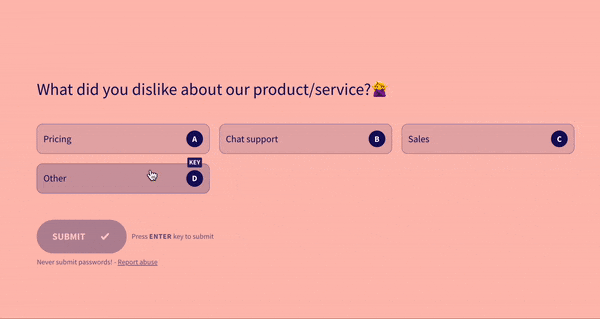No matter how great your product is, customer churn is inevitable. But with a well-timed customer exit survey, you can actually make this churn work in your favor..
How? Well, in this article, we’re going to cover just that, along with:
- Questions to ask + customer exit survey template
- How customer exit surveys can work in your favor
- Best practices for a customer exit survey
What is a customer exit survey?
A customer exit survey (also known as customer cancellation survey or customer churn survey) is a questionnaire shared with a customer who’s a click away from canceling their account or subscription to your product.
This can be shared as a pop-up, text message, email, or an online link.
Nine customer exit survey questions you need to ask
Looking to simplify your customer exit process? Boost customer loyalty? Or improve customer retention?
Don’t let valuable feedback slip away. Use SurveySparrow‘s Customer Exit Survey Template today, and discover how to keep your customers coming back.
Customer Exit Survey Template
Use This TemplateNow, let's explore the customer exit survey questions you should ask.
#1. May we know your name, please?
What it tells you: While this might seem basic, a report by Glance shows that, on average, customer service agents only ask for a customer’s name 21% of the time.
This is a huge miss; by requesting a customer’s name, you can:
- Establish a personal connection.
- Make the survey feel like a conversation.
- Pull up the records on the customer’s sales interactions.
- Educate yourself on the customer’s background and history before following up.
#2. Hello, [Name]. What did you enjoy about our product/service?
What it tells you: This exit survey question can help you understand the perceived benefits of your product or service. If your customer is the angry type, it can remind them of why they signed up for the product in the first place.
You might also get a negative or no-reply on this question. SurveySparrow lets you include a “Skip Question” and ‘Edit Submission” option on your surveys; your customer can go back and edit their response if they change their mind.
#3. What did you dislike about our product/service?
What it tells you: The flaws in your product. This question is best framed as a multiple-choice to make it easier for a customer to answer. We recommend using four choices with “Other” as the last choice.
SurveySparrow’s MCQ question type enables the respondent to follow up with an open-ended response within the MCQ itself.

#4. What is your reason for no longer doing business with us? (or any variation of this question)
What it tells you: The primary reason for churn. This question can be framed as either a multiple choice or open-ended question.
On SurveySparrow, you can enable Voice Transcription on open-ended questions. This enables respondents to literally speak their mind.
#5. What would have prevented you from leaving?
What it tells you: A potential solution for the problem. When enough customers give similar replies, it sheds light on what you need to change in your product.
This step will help you retain more customers and reduce churn.
#6. How likely are you to recommend our product/services to a friend or colleague?
What it tells you: Who your detractors are. It might seem strange to ask a departing (and probably unhappy) client if they will recommend you. But it’s actually a chance to reach out to a dissatisfied user in private before they vent in public.
SurveySparrow’s Ticket Management feature lets you create tickets for responses. This enables your team members to reach out and try to resolve the problem if possible. In addition, this can leave the door open for the customer to consider returning in the future.
#7. How satisfied were you while using our product/service?
What it tells you: If your customers had a good experience with your product. Satisfied customers leave for reasons that are not related to the product.
These customers are more likely to recommend you to others and maybe even come back once the time is right.
#8. Please tell us how we can do better.
What it tells you: Any additional information that you can use to refine the product, system or processes.
If you see recurring feedback in the responses, you may want to consider sharing those with your product team.
#9. Do you still want to stay subscribed to our newsletter?
What it tells you: Which customers want to stick around. This could open the door to a reconsideration once you have the features they want.
In addition, you can use the newsletter to keep them informed about product updates and upgrades.
Note: A hard landscaping company boosted its CSAT scores by more than 18% using SurveySparrow. Find out how.
How customer exit surveys can work in your favor
#1. You get to find out why they’re leaving
Why should you interview a customer who’s already decided to leave? Because a customer exit interview can also tell you why they chose to leave. Maybe…
- They found software that better matches their needs.
- Their trial account expired before they were ready to commit.
- They don’t need your product anymore.
- They signed up for your product, but they’re only using some features.
- There are specific software flaws that you’re unaware of.
- They are using the product for use cases you hadn’t considered, and consequently, the user experience is lagging.
- They are not getting timely support from your customer support.
- The product’s marketing doesn’t match reality.
- They found your sales tactics too pushy or aggressive.
- They can’t afford to continue the subscription, or your product has become too expensive.
- Your primary user/point of contact has left their company.
All of these situations lead to customer churn. However, some have nothing to do with your product. Some are entirely beyond your control, and some can be saved with a timely customer churn survey.
Investing in new customers is between 5x to 25x more expensive than retaining existing ones. – Invesp
#2. You get specific feedback on the areas that need to improve
We noticed from our Trustpilot reviews that compared to praises, user complaints tended to be more specific in their examples.
While I don’t understand why exactly, I suspect that it could simply be due to a need for closure.
For this reason, customer exit survey feedback can offer specific insights on areas that need to improve. For example:
- Product-market fit: Are you marketing to the right audience?
- Customer intent and usage: What job was your customer looking to do with your product?
- Sales: Was it product-focused or solution-focused? Did they uncover uses for the product the customer hadn’t thought of?
- Features: Does your product have the right toolset?
- Support: Were there any gaps in customer support?
- Competitors: How do your competitors compare?
- Processes: Was there anything that could have been done differently?
#3. You get to leave a good lasting impression
The insights above can refine your product, improve your customer experience, and prevent further customer exits for similar reasons.
In some cases, you can even convince a customer who is on the verge of leaving to stick around because you will act on their feedback.
You can also think about the customer exit process as your ultimate, last chance to leave a good impression on the customer.
Why? Think about the last time you ate pineapple pizza. Maybe the first thing that came to your mind was the sweetness of the pineapple, mixed with all that salty cheesiness.
Or you might have gagged on the first slice. But this experience colored the way you felt about pineapple pizza afterward. Psychologists call this the peak-end rule.
Similarly, the last impression of your product will be what customers take with them when they leave. And you don’t want them to leave on a sour note.
Only 1 in 26 customers will tell a business about their negative experience. The rest just leave. – Esteban Kolsky
So, a customer cancellation survey should be included in your customer exit process if it isn’t already.

Customer Exit Survey Process: Best Practices
- Keep it short and straightforward. An exiting customer has no reason to stick around. Depending on the target audience and survey channel, you can stick to just two questions: “Reason for leaving” and “How can we do better?”
- Share the customer churn survey at the time of cancellation. At this time, the product experience is still fresh. Once they leave, the customer will not give much thought to your product.
- Personalize your survey. Send the customer a short, personalized message or email thanking them for choosing your product, and then follow up with the exit survey. This will lead to better response rates.
Wrapping Up
Instead of stressing over churn rates, you can use customer exit surveys to get great feedback that will improve your business overall – processes, products, and systems.
After all, the customer has already decided to leave. So you have nothing to lose from asking them for feedback.
At worst, you will be ignored. At best, you will gain the customer’s honest opinion. This will only result in better customer experience, improved customer satisfaction, and visibly stronger customer retention.






